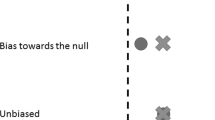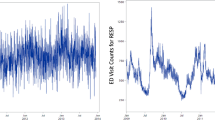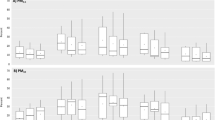Abstract
Background
Short-term mobile monitoring campaigns to estimate long-term air pollution levels are becoming increasingly common. Still, many campaigns have not conducted temporally-balanced sampling, and few have looked at the implications of such study designs for epidemiologic exposure assessment.
Objective
We carried out a simulation study using fixed-site air quality monitors to better understand how different short-term monitoring designs impact the resulting exposure surfaces.
Methods
We used Monte Carlo resampling to simulate three archetypal short-term monitoring sampling designs using oxides of nitrogen (NOx) monitoring data from 69 regulatory sites in California: a year-around Balanced Design that sampled during all seasons of the year, days of the week, and all or various hours of the day; a temporally reduced Rush Hours Design; and a temporally reduced Business Hours Design. We evaluated the performance of each design’s land use regression prediction model.
Results
The Balanced Design consistently yielded the most accurate annual averages; while the reduced Rush Hours and Business Hours Designs generally produced more biased results.
Significance
A temporally-balanced sampling design is crucial for short-term campaigns such as mobile monitoring aiming to assess long-term exposure in epidemiologic cohorts.
Impact statement
Short-term monitoring campaigns to assess long-term air pollution trends are increasingly common, though they rarely conduct temporally balanced sampling. We show that this approach produces biased annual average exposure estimates that can be improved by collecting temporally-balanced samples.
This is a preview of subscription content, access via your institution
Access options
Subscribe to this journal
Receive 6 print issues and online access
$259.00 per year
only $43.17 per issue
Buy this article
- Purchase on Springer Link
- Instant access to full article PDF
Prices may be subject to local taxes which are calculated during checkout



Similar content being viewed by others
Data availability
Air pollution data are available through the EPA (https://www.epa.gov/outdoor-air-quality-data). The covariates used in this analysis for regulatory sites are freely available through various online sources and may be available from the authors upon request.
References
Hankey S, Marshall JD. Land use regression models of on-road particulate air pollution (Particle Number, Black Carbon, PM2.5, Particle Size) using mobile monitoring. Environ Sci Technol. 2015;49:9194–202.
Apte JS, Messier KP, Gani S, Brauer M, Kirchstetter TW, Lunden MM, et al. High-resolution air pollution mapping with google street view cars: Exploiting big data. Environ Sci Technol. 2017;51:6999–7008.
Hatzopoulou M, Valois MF, Levy I, Mihele C, Lu G, Bagg S, et al. Robustness of land-use regression models developed from mobile air pollutant measurements. Environ Sci Technol. 2017;51:3938–47.
Patton AP, Perkins J, Zamore W, Levy JI, Brugge D, Durant JL. Spatial and temporal differences in traffic-related air pollution in three urban neighborhoods near an interstate highway. Atmos Environ. 2014;99:309–21
Van den Bossche J, Peters J, Verwaeren J, Botteldooren D, Theunis J De, et al. Mobile monitoring for mapping spatial variation in urban air quality: Development and validation of a methodology based on an extensive dataset. Atmos Environ. 2015;105:148–61.
Kerckhoffs J, Hoek G, Messier KP, Brunekreef B, Meliefste K, Klompmaker JO, et al. Comparison of ultrafine particle and black carbon concentration predictions from a mobile and short-term stationary land-use regression model. Environ Sci Technol. 2016;50:12894–902.
Xie X, Semanjski I, Gautama S, Tsiligianni E, Deligiannis N, Rajan TR, et al. A review of urban air pollution monitoring and exposure assessment methods. ISPRS Int J Geo-Inform. 2017;6:389.
Hatzopoulou M, Valois MF, Levy I, Mihele C, Lu G, Bagg S, et al. Robustness of land-use regression models developed from mobile air pollutant measurements. Environ Sci Technol. 2017;51:3938–47.
Messier KP, Chambliss SE, Gani S, Alvarez R, Brauer M, Choi JJ, et al. Mapping air pollution with google street view cars: Efficient approaches with mobile monitoring and land use regression. Environ Sci Technol. 2018;52:12563–72.
Yu CH, Fan Z, Lioy PJ, Baptista A, Greenberg M, Laumbach RJ. A novel mobile monitoring approach to characterize spatial and temporal variation in traffic-related air pollutants in an urban community. Atmos Environ. 2016;141:161–73.
Batterman S, Cook R, Justin T. Temporal variation of traffic on highways and the development of accurate temporal allocation factors for air pollution analyses. Atmos Environ. 2015;107:351–63.
Kerckhoffs J, Hoek G, Gehring U, Vermeulen R. Modelling nationwide spatial variation of ultrafine particles based on mobile monitoring. Environ Int. 2021;154:106569.
Minet L, Liu R, Valois MF, Xu J, Weichenthal S, Hatzopoulou M. Development and comparison of air pollution exposure surfaces derived from on-road mobile monitoring and short-term stationary sidewalk measurements. Environ Sci Technol. 2018;52:3512–9.
Abernethy RC, Allen RW, McKendry IG, Brauer M. A land use regression model for ultrafine particles in Vancouver, Canada. Environ Sci Technol. 2013;47:5217–25.
Farrell W, Weichenthal S, Goldberg M, Valois M-F, Shekarrizfard M, Hatzopoulou M. Near roadway air pollution across a spatially extensive road and cycling network. Environ Pollut. 2016;212:498–507.
Montagne DR, Hoek G, Klompmaker JO, Wang M, Meliefste K, Brunekreef B. Land use regression models for ultrafine particles and black carbon based on short-term monitoring predict past spatial variation. Environ Sci Technol. 2015;49:8712–20.
Patton AP, Zamore W, Naumova EN, Levy JI, Brugge D, Durant JL. Transferability and generalizability of regression models of ultrafine particles in urban neighborhoods in the boston area. Environ Sci Technol. 2015;49:6051–60.
Ragettli MS, Ducret-Stich RE, Foraster M, Morelli X, Aguilera I, Basagaña X, et al. Spatio-temporal variation of urban ultrafine particle number concentrations. Atmos Environ. 2014;96:275–83.
Rivera M, Basagaña X, Aguilera I, Agis D, Bouso L, Foraster M, et al. Spatial distribution of ultrafine particles in urban settings: A land use regression model. Atmos Environ. 2012;54:657–66.
Saraswat A, Apte JS, Kandlikar M, Brauer M, Henderson SB, Marshall JD. Spatiotemporal land use regression models of fine, ultrafine, and black carbon particulate matter in New Delhi, India. Environ Sci Technol. 2013;47:12903–11.
Simon MC, Patton AP, Naumova EN, Levy JI, Kumar P, Brugge D, et al. Combining measurements from mobile monitoring and a reference site to develop models of ambient ultrafine particle number concentration at residences. Environ Sci Technol. 2018;52:6985–95.
van Nunen E, Vermeulen R, Tsai M-Y, Probst-Hensch N, Ineichen A, Davey M, et al. Land use regression models for ultrafine particles in six European areas. Environ Sci Technol. 2017;51:3336–45.
Weichenthal S, Ryswyk KVan, Goldstein A, Bagg S, Shekkarizfard M, Hatzopoulou M. A land use regression model for ambient ultrafine particles in Montreal, Canada: A comparison of linear regression and a machine learning approach. Environ Res. 2016;146:65–72.
Weichenthal S, Van Ryswyk K, Goldstein A, Shekarrizfard M, Hatzopoulou M. Characterizing the spatial distribution of ambient ultrafine particles in Toronto, Canada: A land use regression model. Environ Pollut. 2016;208:241–8
Yu CH, Fan Z, Lioy PJ, Baptista A, Greenberg M, Laumbach RJ. A novel mobile monitoring approach to characterize spatial and temporal variation in traffic-related air pollutants in an urban community. Atmos Environ. 2016;141:161–73.
Saha PK, Li HZ, Apte JS, Robinson AL, Presto AA. Urban ultrafine particle exposure assessment with land-use regression: Influence of sampling strategy. Environ Sci Technol. 2019;53:7326–36.
Sabaliauskas K, Jeong CH, Yao X, Reali C, Sun T, Evans GJ. Development of a land-use regression model for ultrafine particles in Toronto, Canada. Atmos Environ. 2015;110:84–92.
Beelen R, Hoek G, Vienneau D, Eeftens M, Dimakopoulou K, Pedeli X, et al. Development of NO2 and NOx land use regression models for estimating air pollution exposure in 36 study areas in. Eur – ESCAPE Proj Atmos Environ 1994. 2013;72:10–23.
Wolf K, Cyrys J, Harciníková T, Gu J, Kusch T, Hampel R, et al. Land use regression modeling of ultrafine particles, ozone, nitrogen oxides and markers of particulate matter pollution in Augsburg, Germany. Sci Total Environ. 2017;579:1531–40.
Cattani G, Gaeta A, Di Menno di Bucchianico A, De Santis A, Gaddi R, Cusano M, et al. Development of land-use regression models for exposure assessment to ultrafine particles in Rome, Italy. Atmos Environ. 2017;156:52–60.
Hoek G, Beelen R, Kos G, Dijkema M, Zee SC, van der, Fischer PH, et al. Land Use Regression Model for Ultrafine Particles in Amsterdam. Environ Sci Technol. 2011;45:622–8.
Saha PK, Hankey S, Marshall JD, Robinson AL, Presto AA. High-spatial-resolution estimates of ultrafine particle concentrations across the continental United States. Environ Sci Technol. 2021; Available from: https://doi.org/10.1021/acs.est.1c03237
Tessum MW, Sheppard L, Larson TV, Gould TR, Kaufman JD, Vedal S. Improving air pollution predictions of long-term exposure using short-term mobile and stationary monitoring in two US metropolitan regions. Environ Sci Technol. 2021;55:3530–8.
Saha PK, Zimmerman N, Malings C, Hauryliuk A, Li Z, Snell L, et al. Quantifying high-resolution spatial variations and local source impacts of urban ultrafine particle concentrations. Sci Total Environ. 2019;655:473–81.
Karner AA, Eisinger DS, Niemeier DA. Near-roadway air quality: Synthesizing the findings from real-world data. Environ Sci Technol. 2010;44:5334–44.
Riley EA, Banks L, Fintzi J, Gould TR, Hartin K, Schaal LN, et al. Multi-pollutant mobile platform measurements of air pollutants adjacent to a major roadway. Atmos Environ. 2014;98:492–9.
US EPA. Air Quality System (AQS). US Environmental Protection Agency. 2019 [cited 2019 Jun 4]. Available from: https://www.epa.gov/aqs
MESA Air. Data Organization and Operating Procedures (DOOP) for the Multi-Ethnic Study of Atherosclerosis and Air Pollution (MESA Air) and Associated Studies. MESA Air; 2019. Available from: https://www.uwchscc.org/MESAAP/Documents/MESAAirDOOP.pdf
Young MT, Bechle MJ, Sampson PD, Szpiro AA, Marshall JD, Sheppard L, et al. Satellite-Based NO2 and model validation in a national prediction model based on universal kriging and land-use regression. Environ Sci Technol. 2016;50:3686–94.
Keller JP, Olives C, Kim SY, Sheppard L, Sampson PD, Szpiro AA, et al. A unified spatiotemporal modeling approach for predicting concentrations of multiple air pollutants in the multi-ethnic study of atherosclerosis and air pollution. Environ Health Perspect. 2015;123:301–9.
US EPA. AirData Pre-Generated Data Files. US Environmental Protection Agency. 2019 [cited 2019 Dec 7]. Available from: https://aqs.epa.gov/aqsweb/airdata/download_files.html
Minet L, Gehr R, Hatzopoulou M. Capturing the sensitivity of land-use regression models to short-term mobile monitoring campaigns using air pollution micro-sensors. Environ Pollut. 2017;230:280–90.
Saha PK, Li HZ, Apte JS, Robinson AL, Presto AA. Urban ultrafine particle exposure assessment with land-use regression: Influence of sampling strategy. Environ Sci Technol. 2019;53:7326–36.
Chastko K, Adams M. Assessing the accuracy of long-term air pollution estimates produced with temporally adjusted short-term observations from unstructured sampling. J Environ Manag. 2019;240:249–58.
Li L, Girguis M, Lurmann F, Pavlovic N, McClure C, Franklin M, et al. Ensemble-based deep learning for estimating PM2.5 over California with multisource big data including wildfire smoke. Environ Int. 2020;145:106143.
US EPA. Electronic Code of Federal Regulations (e-CFR), Title 40, Chapter 1, Subpart C, Part 58, Appendix E to Part 58 - Probe and Monitoring Path Siting Criteria for Ambient Air Quality Monitoring. United States Environmental Protection Agency (US EPA); 2021 [cited 2021 Aug 4]. Available from: https://www.ecfr.gov/cgi-bin/retrieveECFR?n=40y6.0.1.1.6#ap40.6.58.0000_0nbspnbspnbsp.e
CARB. Annual Network Plan - Covering Monitoring Operations in 25 California Air Districts. California Air Resources Board (CARB); 2021. Available from: https://ww2.arb.ca.gov/sites/default/files/2021-07/2021%20Annual%20Network%20Plan_1.pdf
Hoek G. Methods for assessing long-term exposures to outdoor air pollutants. Curr Environ Health Rep. 2017;4:450–62.
Szpiro AA, Paciorek CJ. Measurement error in two-stage analyses, with application to air pollution epidemiology. Environmetrics. 2013;24:501–17.
Kilian J, Kitazawa M. The emerging risk of exposure to air pollution on cognitive decline and Alzheimer’ s disease e Evidence from epidemiological and animal studies. Biomed J. 2018;41:141–62.
Lane KJ, Levy JI, Scammell MK, Peters JL, Patton AP, Reisner E, et al. Association of modeled long-term personal exposure to ultrafine particles with inflammatory and coagulation biomarkers. Environ Int. 2016;92–93:173–82.
Weichenthal S, Olaniyan T, Christidis T, Lavigne E, Hatzopoulou M, Van Ryswyk K, et al. Within-city Spatial Variations in Ambient Ultrafine Particle Concentrations and Incident Brain Tumors in Adults. Epidemiology. 2020;31:177.
US EPA. Integrated science assessment (ISA) for particulate matter (final report, Dec 2019). US Environ Prot Agency. 2019.
Riffault V, Arndt J, Marris H, Mbengue S, Setyan A, Alleman LY, et al. Fine and Ultrafine Particles in the Vicinity of Industrial Activities: A Review. Crit Rev Environ Sci Technol. 2015;45:2305–56.
Funding
This work was funded by the Adult Changes in Thought – Air Pollution (ACT-AP) Study (National Institute of Environmental Health Sciences [NIEHS], National Institute on Aging [NIA], R01ES026187), and BEBTEH: Biostatistics, Epidemiologic & Bioinformatic Training in Environmental Health (NIEHS, T32ES015459). Research described in this article was conducted under contract to the Health Effects Institute (HEI), an organization jointly funded by the United States Environmental Protection Agency (EPA) (Assistance Award No. CR-83998101) and certain motor vehicle and engine manufacturers. The contents of this article do not necessarily reflect the views of HEI, or its sponsors, nor do they necessarily reflect the views and policies of the EPA or motor vehicle and engine manufacturers.
Author information
Authors and Affiliations
Contributions
MNB: data curation, formal analysis, software, investigation, methodology, software, visualization, writing – original draft and editing. AD: formal analysis, validation, visualization, writing – review, and editing. EA: writing – review, and editing. JDM: Conceptualization, writing – review, and editing. ES: writing – review, and editing. TL: Writing – review, and editing. LS: Conceptualization, methodology, funding acquisition, resources, supervision, writing – original draft, review, and editing.
Corresponding authors
Ethics declarations
Competing interests
The authors declare no competing interests.
Ethical approval
No humans or animals were involved in this work.
Additional information
Publisher’s note Springer Nature remains neutral with regard to jurisdictional claims in published maps and institutional affiliations.
Supplementary information
Rights and permissions
Springer Nature or its licensor holds exclusive rights to this article under a publishing agreement with the author(s) or other rightsholder(s); author self-archiving of the accepted manuscript version of this article is solely governed by the terms of such publishing agreement and applicable law.
About this article
Cite this article
Blanco, M.N., Doubleday, A., Austin, E. et al. Design and evaluation of short-term monitoring campaigns for long-term air pollution exposure assessment. J Expo Sci Environ Epidemiol 33, 465–473 (2023). https://doi.org/10.1038/s41370-022-00470-5
Received:
Revised:
Accepted:
Published:
Issue Date:
DOI: https://doi.org/10.1038/s41370-022-00470-5



